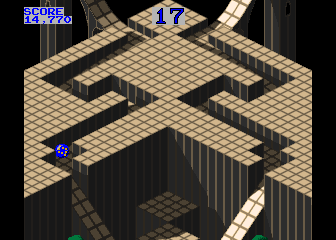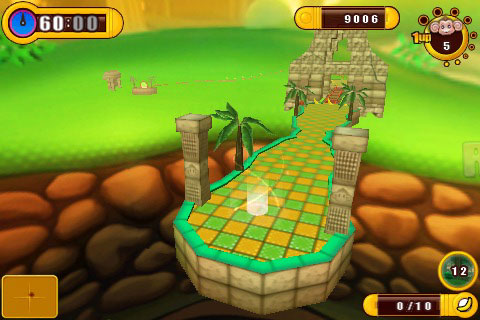Mercury Hg (I know it’s tautological—you won’t believe the number of people who insisted on telling me this!) is the latest puzzle-slash-rolling platformer game in a series that started life as Archer Maclean’s Mercury on the PSP. Find out whether this game is completely Boron, a pain in the Arsenic, or pure, unadulterated Gold: after the Br…eak.
I’m not going to make this review any more painful in the pun department than I already have. I am oh so sorely temped; there are so many terrible puns one could make from the periodic table of elements alone, but, for the sake of your sanity, I’ll caesium.
Drat.
Let’s try that again. I know precisely what I’ll do with any further puns. I’ll barium. Gah…Let’s try that again!
Despite the desperately tinny attempts at being funny (did it again!), I’ve inadvertently given you an insight into what playing Mercury Hg is like. Don’t understand? Stick around for a few more paragraphs; I’ll elucidate for you. And no, for the less educated among you, “elucidate” isn’t on the periodic table of elements, even though I feel it should be. [Ed: Elucidate hydrochloride? Potassium elucidate?]
First, the mandatory history lesson, or as I call it: “the review tax”! Personally, I feel it’s important to understand where a game comes from; know thy foe, as they say. This time, we’re going to spin the time machine back to 1984, back when video arcades were still the best way to get your gaming fix, and when Atari was a household name in the same way that “Playstation” or “Xbox” is today. Let’s creep into one of those brightly coloured video arcades, shall we? There, the cabinet toward the middle. No, not the one with the joystick; we’re interested in the one with the track ball. Yep, that’s Marble Madness.  Yes, I know, unusual controls, but it makes sense when you realize that you’re actually controlling a marble in this game, trying to navigate the obstacles and get to a bunch of tiles marked “GOAL”. In its day, Marble Madness was revolutionary, and the arcade cabinets were extremely profitable. Fast forward a year later, and we see a similar game called Gyroscope, this time for home computer systems. Another year, and we see Spindizzy, once again featuring the same isometric view, clean lines, and addictive gameplay. Forward to 1989, and we see a game called Cameltry.
Yes, I know, unusual controls, but it makes sense when you realize that you’re actually controlling a marble in this game, trying to navigate the obstacles and get to a bunch of tiles marked “GOAL”. In its day, Marble Madness was revolutionary, and the arcade cabinets were extremely profitable. Fast forward a year later, and we see a similar game called Gyroscope, this time for home computer systems. Another year, and we see Spindizzy, once again featuring the same isometric view, clean lines, and addictive gameplay. Forward to 1989, and we see a game called Cameltry.  It’s the same sort of game, but this time we see only a 2D, side view of the game board; in other words, you rotate the screen to move the ball to the goal.
It’s the same sort of game, but this time we see only a 2D, side view of the game board; in other words, you rotate the screen to move the ball to the goal.
 Let’s set the time machine for the turn of the millennium, shall we? Also, we’ll land outside a Japanese video arcade instead of one of the more familiar western ones. Yes, yes, I know you’ve not seen those machines before; they’re called Pachinko machines, but we’re not interested in them, except perhaps in the most tangential manner. No, look over there at the arcade machine with the banana-shaped joystick.
Let’s set the time machine for the turn of the millennium, shall we? Also, we’ll land outside a Japanese video arcade instead of one of the more familiar western ones. Yes, yes, I know you’ve not seen those machines before; they’re called Pachinko machines, but we’re not interested in them, except perhaps in the most tangential manner. No, look over there at the arcade machine with the banana-shaped joystick.
 You can also stop laughing now, thank you very much. That’s where Marble Madness, Cameltry, and Mercury Hg overlap somewhat, in an overly cutesy game called Super Monkey Ball. The difference between Madness and Monkey Ball is that, instead of directly controlling the marble, you now control the platform it sits under. Yes, and this marble contains a monkey. Will you kindly focus on this game and leave the dratted monkeys alone? Yes, I know they’re cute. As I was saying, moving the control from the marble to the platform changed the nature of the challenge somewhat, and if anything, made for more frantic gameplay.
You can also stop laughing now, thank you very much. That’s where Marble Madness, Cameltry, and Mercury Hg overlap somewhat, in an overly cutesy game called Super Monkey Ball. The difference between Madness and Monkey Ball is that, instead of directly controlling the marble, you now control the platform it sits under. Yes, and this marble contains a monkey. Will you kindly focus on this game and leave the dratted monkeys alone? Yes, I know they’re cute. As I was saying, moving the control from the marble to the platform changed the nature of the challenge somewhat, and if anything, made for more frantic gameplay.

Fast forward five more years to 2005, and Archer Maclean’s Mercury had just been released on the PSP, to much acclaim. It took the marble-rolling aspect of Marble Madness, mixed it with the control scheme of Monkey Ball, and added a whole new puzzle twist to the mix. The blob of mercury behaved much as one expected a blob of metallic liquid to: it morphed, split up into component droplets, and rolled around the board with about as much reckless abandon as the liquid metal T-1000 from Terminator 2. It was amazing fun; I recall the first time I played it I couldn’t put the game down. The puzzle element is what really made the game come alive in a way that sickeningly cute monkeys could never do.
 And so, finally, we ease back into the present (future?) to the latest instalment in the Mercury series. Assuming you never played the brilliant, original Mercury, Mercury Hg (which I’m assuming is another pun, this time on what Mercury Hg actually is: an HD version of the game. Get it? Hg? HD? Yes, it’s a scandium) sees you controlling the ground beneath a blob of mercury, racing through an obstacle-course-like level, collecting molecules, and trying to make it through the level with all the mercury intact. Along the way, you find things that make your blob different colours, spikes that split your blob into smaller blobs, switches that you can activate, and various other obstacles that make getting to the end intact somewhat a challenge. Attaining the end of each level awards you points towards unlocking the next set of levels, whereupon you rinse, and repeat. For 60 levels. On top of the main “Discovery” mode, there are also bonus levels, that task you with completing the levels with 100% of your blob. On top of that, there is also the “Challenge” mode, which has you completing a specified number of levels in a row, while fulfilling certain criteria. Some of these levels can be maddeningly difficult, and of course, you’re also up against a clock, so you can’t take your time.
And so, finally, we ease back into the present (future?) to the latest instalment in the Mercury series. Assuming you never played the brilliant, original Mercury, Mercury Hg (which I’m assuming is another pun, this time on what Mercury Hg actually is: an HD version of the game. Get it? Hg? HD? Yes, it’s a scandium) sees you controlling the ground beneath a blob of mercury, racing through an obstacle-course-like level, collecting molecules, and trying to make it through the level with all the mercury intact. Along the way, you find things that make your blob different colours, spikes that split your blob into smaller blobs, switches that you can activate, and various other obstacles that make getting to the end intact somewhat a challenge. Attaining the end of each level awards you points towards unlocking the next set of levels, whereupon you rinse, and repeat. For 60 levels. On top of the main “Discovery” mode, there are also bonus levels, that task you with completing the levels with 100% of your blob. On top of that, there is also the “Challenge” mode, which has you completing a specified number of levels in a row, while fulfilling certain criteria. Some of these levels can be maddeningly difficult, and of course, you’re also up against a clock, so you can’t take your time.
 The look of the game is bright and colourful, and delightfully eye-catching. Bear in mind that I had been playing Gears “I must have more brown” of War 3, so the colours are a lovely respite. The background in each level acts as a graphic equalizer of sorts, and thumps along to the music. The music that ships with the game is fairly forgettable, so it’s great that, from within the game, select some of your own music, and have the background thump along to that. I heartily recommend the Imperial March from Star Wars, by the way.
The look of the game is bright and colourful, and delightfully eye-catching. Bear in mind that I had been playing Gears “I must have more brown” of War 3, so the colours are a lovely respite. The background in each level acts as a graphic equalizer of sorts, and thumps along to the music. The music that ships with the game is fairly forgettable, so it’s great that, from within the game, select some of your own music, and have the background thump along to that. I heartily recommend the Imperial March from Star Wars, by the way.
 If you own the XBLA version of the game, you’re stuck with using the standard control scheme. If you want to add an extra layer of challenge, however, grab the PS3 version, which has support for the Sixaxis controller. Seems counter-intuitive, but the motion control actually makes the game more difficult, not less. It’s a heck of a lot of fun to play this way, though. And if you’re a trophy addict, there’s even a trophy just for trying the motion controls. Isn’t that nice?
If you own the XBLA version of the game, you’re stuck with using the standard control scheme. If you want to add an extra layer of challenge, however, grab the PS3 version, which has support for the Sixaxis controller. Seems counter-intuitive, but the motion control actually makes the game more difficult, not less. It’s a heck of a lot of fun to play this way, though. And if you’re a trophy addict, there’s even a trophy just for trying the motion controls. Isn’t that nice?
 Despite the fun of the original Mercury, this incarnation seems somewhat…less. The puzzles were never hard enough to stump me, and more emphasis seems to be placed on manual dexterity than cranium ability. Not that this is a bad thing, mind, but given where much of the fun of the original came from, it seems an odd omission. The game features—and features quite heavily—an online leaderboard, however, and this gives me a segue into my first few paragraphs: if you want to be near the top of the leaderboards, you’re going to have to play some levels over again and again and again and again…and then add perhaps another 200 agains for good measure. The game keeps a tally of your score, your time, and the number of attempts you’ve made at a level. When I last checked, the enterprising chap at the top of the boards made an average of around 200 attempts per boards. My main issue with the leaderboard, however, is that the game is forever hitting you over the head with it. At the end of each level, you have to go through three leaderboards just to get to the next stage. If your Internet connection is slow, or flaky, it can take a short while before you finally arrive at the next level. This can be a little on the frustrating side if you’re itching to move on and don’t particularly care about where you are ranked in the world. It would have been nice to either be able to turn this off, limit it to a single board, or limit it to friends only, making it a quicker transition between levels.
Despite the fun of the original Mercury, this incarnation seems somewhat…less. The puzzles were never hard enough to stump me, and more emphasis seems to be placed on manual dexterity than cranium ability. Not that this is a bad thing, mind, but given where much of the fun of the original came from, it seems an odd omission. The game features—and features quite heavily—an online leaderboard, however, and this gives me a segue into my first few paragraphs: if you want to be near the top of the leaderboards, you’re going to have to play some levels over again and again and again and again…and then add perhaps another 200 agains for good measure. The game keeps a tally of your score, your time, and the number of attempts you’ve made at a level. When I last checked, the enterprising chap at the top of the boards made an average of around 200 attempts per boards. My main issue with the leaderboard, however, is that the game is forever hitting you over the head with it. At the end of each level, you have to go through three leaderboards just to get to the next stage. If your Internet connection is slow, or flaky, it can take a short while before you finally arrive at the next level. This can be a little on the frustrating side if you’re itching to move on and don’t particularly care about where you are ranked in the world. It would have been nice to either be able to turn this off, limit it to a single board, or limit it to friends only, making it a quicker transition between levels.
 The issues with the game are reasonably minor, however, and Mercury Hg is perfectly suited as a chaser game for playing after a gruelling gaming session, or as a game to play when you need to just chill out and not think too hard. It’s not quite the worthy successor to the original Archer Maclean’s Mercury, but it’s still a good lot of fun, and you really can’t ask for more from a game than that.
The issues with the game are reasonably minor, however, and Mercury Hg is perfectly suited as a chaser game for playing after a gruelling gaming session, or as a game to play when you need to just chill out and not think too hard. It’s not quite the worthy successor to the original Archer Maclean’s Mercury, but it’s still a good lot of fun, and you really can’t ask for more from a game than that.
Score: 8 mercury-free prawns out of 10
Detailed information:
Developer: Eiconic Games
Release Date: 17 September2011
Platform: PSN and XBLA
RRP: R45 (PSN) 400 points (Live)
Age rating: 3


